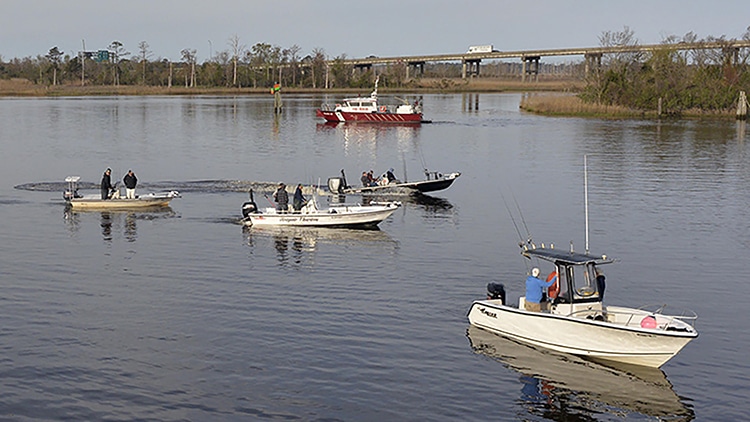High Levels of PFAS Affect Immune, Liver Functions in Cape Fear River Striped Bass

Researchers from North Carolina State University have found elevated levels of 11 per- and polyfluoroalkyl (PFAS) chemicals in the blood of Cape Fear River striped bass. Two of those compounds – perfluorooctane sulfonate (PFOS) and Nafion byproduct 2 – are associated with altered immune and liver functions in those fish.
Scott Belcher, associate professor of biology and corresponding author of a paper describing the research, led a team that included NC State colleagues Detlef Knappe, Ben Reading and postdoctoral researcher Theresa Guillette as well as partners from the North Carolina Wildlife Commission and the U.S. Environmental Protection Agency (EPA).
The team isolated serum from the blood of 58 wild caught Cape Fear River striped bass ranging in age from 2 to 7 years old. In collaboration with EPA researchers Mark Stryner and James McCord, they determined the concentrations of 23 different PFAS chemicals present in the serum using a combination of liquid chromatography and high-resolution mass spectrometry.
“Testing blood levels gives you an idea of the ‘body burden’ of these particular chemicals,” Belcher says. “The levels of these chemicals in the water were measured in parts per trillion, but in the serum of the fish levels are higher and in parts per billion, demonstrating that they have clearly bioaccumulated in these fish.”
The team then compared the blood serum samples from the wild caught fish to those from a reference population of 29 striped bass raised in an aquaculture facility fed by ground water. “The serum levels of chemicals in the wild caught bass were 40% higher, on average, than the background levels found in this reference population,” Belcher says.
In comparison to the levels of PFAS found in Cape Fear River water, elevated levels of PFOS and Nafion byproduct 2 were found in 100% and 78% of the wild bass samples, respectively. The serum concentrations of these compounds were associated with biomarkers of altered liver enzyme activity and immune function in those fish.
“These PFAS levels are some of the highest recorded in fish,” Belcher says, “but one of the most unusual findings here is that smaller or younger fish had the highest levels of these compounds. This points to the fact that PFAS chemicals are very different from other persistent chemicals, like mercury or PCBs. They have unique and very different chemical properties that cause them to bioaccumulate differently, and we’re really just beginning to understand why and how they do what they do.”
The work appears in Environment International, and was supported in part by the National Institute of Environmental Health Sciences (award numbers P30ES025128 and R21ES029353), and a North Carolina Sea Grant Community Collaborative Research Grant. Theresa Guillette is first author. Matthew Guillette, M.E. Polera and Nadine Kotlarz from NC State, as well as Kyle Rachels and Clint Morgeson from the N.C. Wildlife Resources Commission, also contributed to the work.
-peake-
Note to editors: An abstract follows.
“Elevated Per- and Polyfluoroalkyl Substances in Cape Fear River Striped Bass (Morone saxatilis) are Associated with Biomarkers of Altered Immune and Liver Function”
DOI: 10.1016/j.envint.2019.105358
Authors: T.C. Guillette, Matthew Guillette, M.E. Polera, Nadine Kotlarz, Detlef Knappe, Benjamin J. Reading, Scott Belcher, North Carolina State University; James McCord, Mark Strynar, National Exposure Research Laboratory, ORD, U.S. EPA, Research Triangle Park, North Carolina; Kyle Rachels, Clint Morgeson, N. C. Wildlife Resources Commission, Inland Fisheries Division Raleigh, NC
Published: Feb. 7 in Environment International
Abstract:
Per- and polyfluoroalkyl substances (PFAS)
are anthropogenic chemicals of concern that persist within the environment.
Environmental monitoring revealed high concentrations of hexafluoropropylene
oxide dimer acid (HFPO-DA) and other novel PFAS in the lower Cape Fear River;
however, there is limited information on PFAS exposures and effects of this
contamination on aquatic biota. Serum concentrations of 23 different PFAS in
Striped Bass (Morone saxatilis) from
the Cape Fear River (n=58), and a reference population from an aquaculture
laboratory on the Pamlico/Tar watershed (n=29), were quantified using liquid
chromatography, high-resolution mass spectrometry, and correlations between
PFAS concentrations and health-related serum biomarkers were evaluated.
Perfluorooctane sulfonate, the predominant PFAS in Cape Fear River Striped Bass
serum, was detectable in every sample with serum concentrations reaching 977
ng/mL. Perfluorononanoic and perfluorodecanoic acid were also detected in all
samples, with perfluorohexanesulfonic acid present in >98% of the samples.
HFPO-DA (range <0.24-5.85 ng/mL) and Nafion byproduct 2 (range <0.2–1.03
ng/mL) were detected in 48% and 78% of samples, respectively. The mean total
PFAS concentration found in domestic Striped Bass raised in well-water under controlled aquaculture
conditions was 40 times lower, with HPFO-DA detected in 10% of the samples, and
Nafion byproduct 2 not detected. The elevated PFAS concentrations found in the
Cape Fear River Striped Bass were associated with biomarkers of alterations in
the liver and immune system.
This post was originally published in NC State News.


